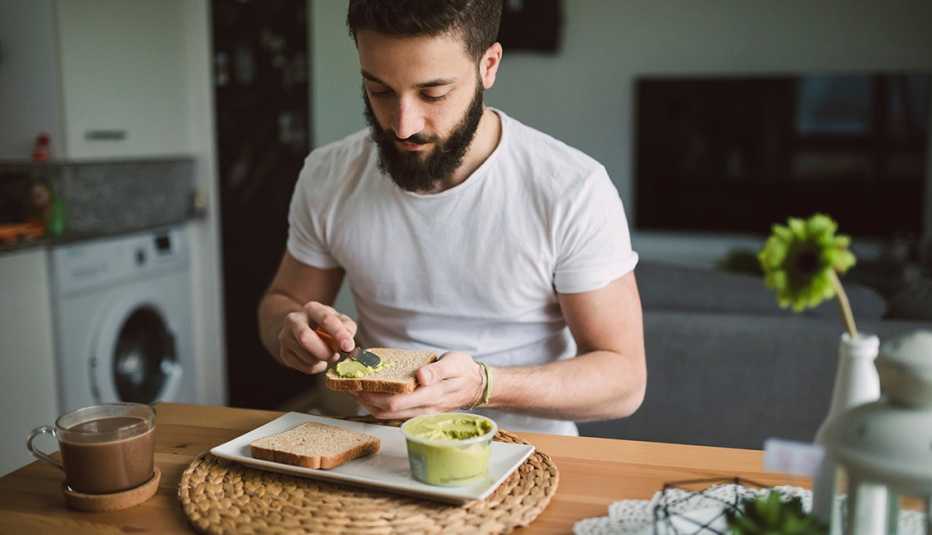AARP Hearing Center


If you are ready to experiment with new healthy foods and recipes in the coming year, it may be time to eat like a millennial.
Take a few cues from the way the younger generation eats, cooks and grocery shops, and you may be inspired to change what's on your plate without compromising your diet or derailing your weight-loss plans. Don't be afraid to tap into an internet full of creative recipes to figure out new ways to cook and diversify the ingredients you work with.
What do millennials eat?
"(Millennials) want what they call ‘clean’ food. What they really mean is that they want ‘real’ food,” said Anne VanBeber, professor of nutrition at Texas Christian University in Fort Worth. “They are interested in how the preparation of the food, the packaging, and the storing of the food impacts the environment."
To eat clean means choosing whole foods such as fruits and vegetables instead of processed snacks and ready-made meals with a list of ingredients that are impossible to pronounce,
The younger generation (late 20s and early 30s) tend to choose beverages such as sparkling water, green tea and kombucha over sugary drinks like soda. And instead of buying groceries at big box or multipurpose stores such as Walmart or Costco, they look for more specialized grocers such as Trader Joe's and Whole Foods, which sell options that are more ethically sourced and contain less processed ingredients, according to a study of 12.5 million millennial social media posts by CBD Marketing.
As you begin your nutritional and weight-loss journey in 2021, consider experimenting with new ingredients and cooking methods that will prevent you from getting bored with your food intake. To get you started, we asked nutrition experts about nine foods from a definitive list of 60 millennial foods by Buzzfeed, a website that reaches nearly 83 percent of millennials, according to Nielsen Holdings.
1. Avocado toast, perhaps the most obvious “millennial” food because it appears on restaurant menus and is a staple of weekend brunch, can make for a nutritious breakfast, lunch, dinner or snack. Avocados are a good source of monounsaturated fatty acids, which are heart healthy and serve as a good fat replacement for butter. The fruit (yes, avocados are a fruit) also contains 10 to 11 grams of fiber per avocado, said VanBeber.
"Pairing a third of an avocado with one slice of 100 percent whole grain bread can provide between 15 to 20 percent of daily fiber needs for adults over 50 years of age,” said Elizabeth Spencer, a registered dietitian at Northwestern Medicine Center DuPage Hospital in Winfield, Illinois.
However, be watchful. One medium avocado packs between 250 and 300 calories, so it may be too many calories for a meal or snack, especially when combined with other food items. Older adults often need fewer calories and higher amounts of specific vitamins, minerals and protein, she added.
2. Cauliflower is a vegetable common to many household crispers that has taken on new popularity as a carb replacement in the form of cauliflower crust and rice. For those looking for a savory alternative, there are also versions of cauliflower “wings” and cauliflower “steak.” These are lower in calories and carbohydrates than their starchy meaty counterparts and, obviously, work for vegans and vegetarians.
"Replacing rice with riced cauliflower or wheat in pizza crust with cauliflower can significantly cut down on carbs while retaining fiber, leading to feelings of fullness, as well as increasing daily veggie servings,” said Spencer. “Cauliflower is also a rich source of choline, which aids in muscle movement, metabolism, and nervous system and brain health.” So, clearly, it's good for people of all ages.




































































More From AARP
Devin Alexander: What I'm Cooking Now
The chef shares recipes for easy, healthy comfort foodSmart Shopping Tips During the Pandemic
Update your grocery list with these recipesWhat to Steal From Keto, Paleo and Other Trendy Diets
Experts sort through the fads to see what really helps you lose weight